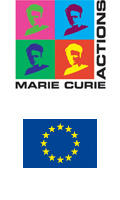Nanowires for nanoelectronics
The aim of this WP is to make a step further in bringing together quantum optics and quantum transport by studying semiconductor nanowires based on the InAsP material. The research focuses on basic properties of these systems as well as on possible applications in quantum information processing and novel opto-electronic devices. In this WP we fabricate and characterise Light-Emitting Diodes (LEDs) based on single nanowires. Our aim is fabrication of an electrically driven single photon source. The active region for electron-hole recombination is formed by a quantum dot. Because all the injected current will flow through the active region, we aim at a very efficient conversion of electron-hole pairs into photons. The quantum dot nanowire LED can ideally be used both as a single photon emitter as well as a photodetector ("a single electron source"). The experiments, in their concept and in the result interpretation, will be supported by the simulation tool developed in this WP.
Quantum optics and quantum transport
InAsP nanowires will be grown by MOVPE for single electron/photon devices. One task will be to optimise and fine tune the impurity doping for both n- and p-type. An important goal is to minimise the concentration of defects, such as twin planes, in the wires, since these will degrade the (opto-) electronic properties of the wires. For the single photon devices short segments, quantum dots (QD), will be integrated in the wires. In order to enhance the uniformity of the optical properties of the QDs across the sample, the wires will be grown from regular arrays of catalyst particles.
Nanowire devices will be fabricated for electronic transport and for opto-electronic purposes. The devices will be of the form of Field Effect Transistors but with gates sufficiently small that individual electrons can be manipulated. This level of electronic control requires a near perfect control over the material structure. We will characterise nanowires grown in the consortium for further optimisation. The final control will not only control individual electrons but do so at very short timescales (nanoseconds).
Nanowires will be developed with a varying doping profile including pn-junctions. In the n-section or the p-section we will incorporate the gate technology for controlling individual electrons. The pn-junction will be used to convert single electron control into single photon control, also at very short timescales. We will characterise pn-junction nanowires grown in the consortium for further optimisation.
Hanbury-Brown and Twiss correlation measurements will be performed by UCAM to determine conditions under which single-photon emission is achieved.
Transport in nanowire based devices
Advanced device modelling requires a combination of non-equilibrium Green's function approaches with many-body Fock space techniques, building the framework for an adequate description of electronic transport and few-electron charging effects in realistic nanodevices. The multi-configurational Green's function approach (MCSCG) incorporates such a concept. This will be the physical framework of the development of a simulation tool for nanowire-based multi-gate transistor structures, including a graphical user interface for device parameter definition and visualisation of simulation results. The analysis of transport properties and electronic structure of realistic nanowire-FETs will be done in collaboration with NANOWIRING partners.

